Bulgaria
For decades, not anymore the nightmare country that was close to the Soviet Union, Bulgaria has quickly won the reputation of one of the top European destinations of every season. The country situates in gorgeous natural scenery in the center and east of the Balkan peninsula, sharing borders with Romania, Macedonia, Serbia, Greece, a bit of Turkey, and some 380 kilometers with the Black Sea.
The history of Bulgaria is as complicated as any other Balkan country. The Bulgar tribes in the 6th century invaded and inherited an area that previously had been occupied by Greek, Roman, and Byzantine culture. Soon they adopted Eastern Orthodoxy and this has left us with numerous churches, cathedrals, and monasteries throughout all Bulgaria. Also, the Ottomans left their mark in Bulgaria with their almost 4 centuries invasion.
One may only have a flank idea of the touristic attractions that may be in Bulgaria only by taking a look at the map of the country. Physically, Bulgaria is divided into two mountain ranges that have a corridor between them. In this particular model, think of the many rivers that stream quickly and with noise throughout the forests with snow. And in your imagination go on up the mountains to reach the tops of the Rhodope Mountains and to be left breathless from the view atop of them. The name of the peninsula comes from mountains here that locals call Stara Planina. Skiing? Not a bad idea; in fact, your biggest problem is to choose between the Stara Planina, the Rila, or the Pirin mountains.
From there, fly to the golden shores of the Black Sea (as ironic as it may be the name). Do you prefer the modern fancy resorts where you can rest and just enjoy everything that is in front of you? Or you would like to enjoy something purer, something more virgin and untouched by any man-made creation? The vast choices will make you think if you have time to visit them all.
With all that Bulgaria offers, you should be careful when joining tours in Bulgaria. You might fall in love with this wonderful piece of nature.
Facts
Population: 7,1million | Capital: Sofia | Language: Bulgarian | Surface: 110,994 km2
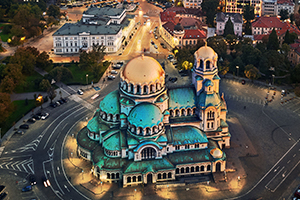 Sofia, the capital of Bulgaria since 1879, may not be the most attractive destination you can find in Bulgaria, but it sure will not disappoint you. It is a combination of the face of a Balkan capital and a European capital, offering the best of both. Ruins of the ancient Roman city of Serdica are found all over the city (you can’t miss the amphitheater) and especially in the museum. Notable is also that remains of different Greek periods are also widespread around Sofia. But advancing a bit more in time, in Sofia you can get your spiritual dose in the Alexander Nevsky orthodox cathedral, one of the biggest in the country. And if you can’t get enough of Sofia, luckily, the capital is located pretty much in the center of the country and it is not difficult to reach other destinations quite fast.
Sofia, the capital of Bulgaria since 1879, may not be the most attractive destination you can find in Bulgaria, but it sure will not disappoint you. It is a combination of the face of a Balkan capital and a European capital, offering the best of both. Ruins of the ancient Roman city of Serdica are found all over the city (you can’t miss the amphitheater) and especially in the museum. Notable is also that remains of different Greek periods are also widespread around Sofia. But advancing a bit more in time, in Sofia you can get your spiritual dose in the Alexander Nevsky orthodox cathedral, one of the biggest in the country. And if you can’t get enough of Sofia, luckily, the capital is located pretty much in the center of the country and it is not difficult to reach other destinations quite fast.
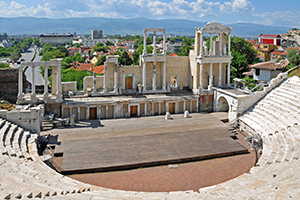 Plovdiv is Bulgaria’s second largest city and maybe the most important reason to visit the city, is the incredibly well preserved Ancient theatre, situated in between two of what is now 6 hills, but the original plan was build on 7 hills on the side of the Rhodope mountain range. Plovdiv is filled with Roman ruins and magnificient Old Town of cobbled streets and where time is stuck in 19th century in the buildings. Considered as one of the oldest cities in Europe (from the ancient roman settlement), actually has a much older history with Neolithic settlements dated at around 6000 B.C. Plovdiv was developed before Bulgaria separated from the Ottoman Empire and the people contributed in the Orthodox church, Bulgarian-language education and culture and in ‘National Revival Architecture’ which we can enjoy today. Nowadays, Plovdiv has the looks of a modern European city but without erasing the traces of history, which you can notice in every corner of the city. Nature does not stands back far behid for it’s river Maritsa streams throughout the city to give more delight to it.
Plovdiv is Bulgaria’s second largest city and maybe the most important reason to visit the city, is the incredibly well preserved Ancient theatre, situated in between two of what is now 6 hills, but the original plan was build on 7 hills on the side of the Rhodope mountain range. Plovdiv is filled with Roman ruins and magnificient Old Town of cobbled streets and where time is stuck in 19th century in the buildings. Considered as one of the oldest cities in Europe (from the ancient roman settlement), actually has a much older history with Neolithic settlements dated at around 6000 B.C. Plovdiv was developed before Bulgaria separated from the Ottoman Empire and the people contributed in the Orthodox church, Bulgarian-language education and culture and in ‘National Revival Architecture’ which we can enjoy today. Nowadays, Plovdiv has the looks of a modern European city but without erasing the traces of history, which you can notice in every corner of the city. Nature does not stands back far behid for it’s river Maritsa streams throughout the city to give more delight to it.
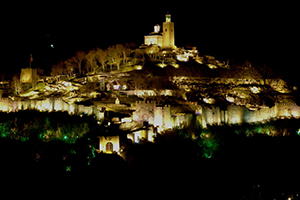 Veliko Tarnovo is a city in north central Bulgaria. It is often referred as the : “City of Tsars”, (title used to designate East and South Slavic monarchs or supreme rulers of Eastern Europe, originally Bulgarian monarchs from 10th century onwards). There are interesting thing to look at like various mediaeval churches with well-preserved frescoes , some decent museums and the lovely cobbled streets of the old town with houses built into the rocks. Veliko Tarnovo is a beautiful place which can be perfectly discovered by walking but since the city was built on several hills, there are some inclinations and sometimes the walks might be long.
Veliko Tarnovo is a city in north central Bulgaria. It is often referred as the : “City of Tsars”, (title used to designate East and South Slavic monarchs or supreme rulers of Eastern Europe, originally Bulgarian monarchs from 10th century onwards). There are interesting thing to look at like various mediaeval churches with well-preserved frescoes , some decent museums and the lovely cobbled streets of the old town with houses built into the rocks. Veliko Tarnovo is a beautiful place which can be perfectly discovered by walking but since the city was built on several hills, there are some inclinations and sometimes the walks might be long.
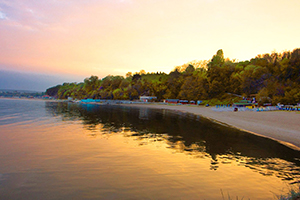 Being the third largest country in Bulgaria is not something taken easily because the top spots are hugely attractive. Neverthelss, Varna compensates the podium with the Black Sea. While Sofia is the capital city all the time, Varna takes that title in the summer, being the most populated and overcrowded city for the hot months. Its golden sand beaches are of the most frequented in Bulgaria. And not just this, but Varna is also the center of the Bulgarian navy and several sea life museums.
Being the third largest country in Bulgaria is not something taken easily because the top spots are hugely attractive. Neverthelss, Varna compensates the podium with the Black Sea. While Sofia is the capital city all the time, Varna takes that title in the summer, being the most populated and overcrowded city for the hot months. Its golden sand beaches are of the most frequented in Bulgaria. And not just this, but Varna is also the center of the Bulgarian navy and several sea life museums.
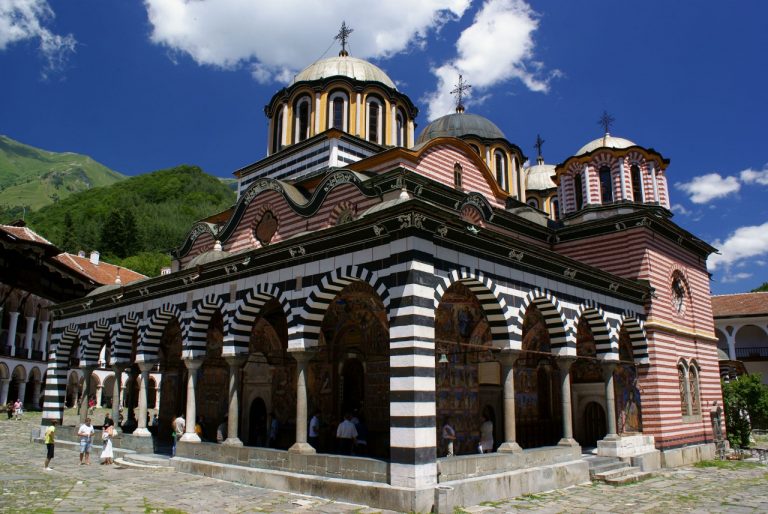 It is nearly impossible to go on a trip in Bulgaria and not to see signs pointing to one or more Orthodox monasteries. They’re colorful, spiritual, quiet, and full of life. There are more than 211 monasteries in Bulgaria. The Monastery of Saint Ivan of Rila, better known as the Rila Monastery is the largest and most famous Eastern Orthodox monastery in Bulgaria.Monasteries are important for Bulgaria as a value for the religion and also important for Bulgaria’s tourism as they attract a massive number of tourists each month of the year.
It is nearly impossible to go on a trip in Bulgaria and not to see signs pointing to one or more Orthodox monasteries. They’re colorful, spiritual, quiet, and full of life. There are more than 211 monasteries in Bulgaria. The Monastery of Saint Ivan of Rila, better known as the Rila Monastery is the largest and most famous Eastern Orthodox monastery in Bulgaria.Monasteries are important for Bulgaria as a value for the religion and also important for Bulgaria’s tourism as they attract a massive number of tourists each month of the year.
We have included tours in Bulgaria because is one of the Major countries in Eastern Europe. The Varna Culture from the 5th century BC is accredited with inventing gold metallurgy. On the other hand, The Balkan mountains run laterally through the middle of the country, with Musala being the highest in the region. On our tours in Bulgaria, you will enjoy visiting some of the most fascinating castles from the Kingdom times of Bulgaria to the Rose Valleys and well preserved Medieval Monasteries.
On our tours in Bulgaria you will:
– Support local communities
– Learn more from our experienced guides
– Travel in modern comfortable vehicles
– Taste some of the best local specialties
– Get plenty of free time to explore on your own way